An Analysis of Supply Chain Management in Co-operative Food
VerifiedAdded on 2020/01/15
|12
|5103
|189
Report
AI Summary
This report provides a comprehensive analysis of the supply chain management practices within Co-operative Food. It begins with an overview of the company, highlighting its history, ethical commitments, and business operations. The introduction defines supply chain management and outlines the report's focus on Co-op Food's strategies and practices, particularly in areas like ethical sourcing, renewable energy, and fair trade. The literature review explores the relationship between supply chain management and organizational objectives, discussing strategic, tactical, and operational levels. It also examines the role of information technology in optimizing supplier relationships, detailing how IT assists in areas like inventory management, forecasting, and reducing transaction costs. Furthermore, the report covers the roles of logistics and procurement in supply chain management. Overall, the report showcases the company's approach to supply chain management, emphasizing its importance in achieving business objectives and maintaining ethical standards.
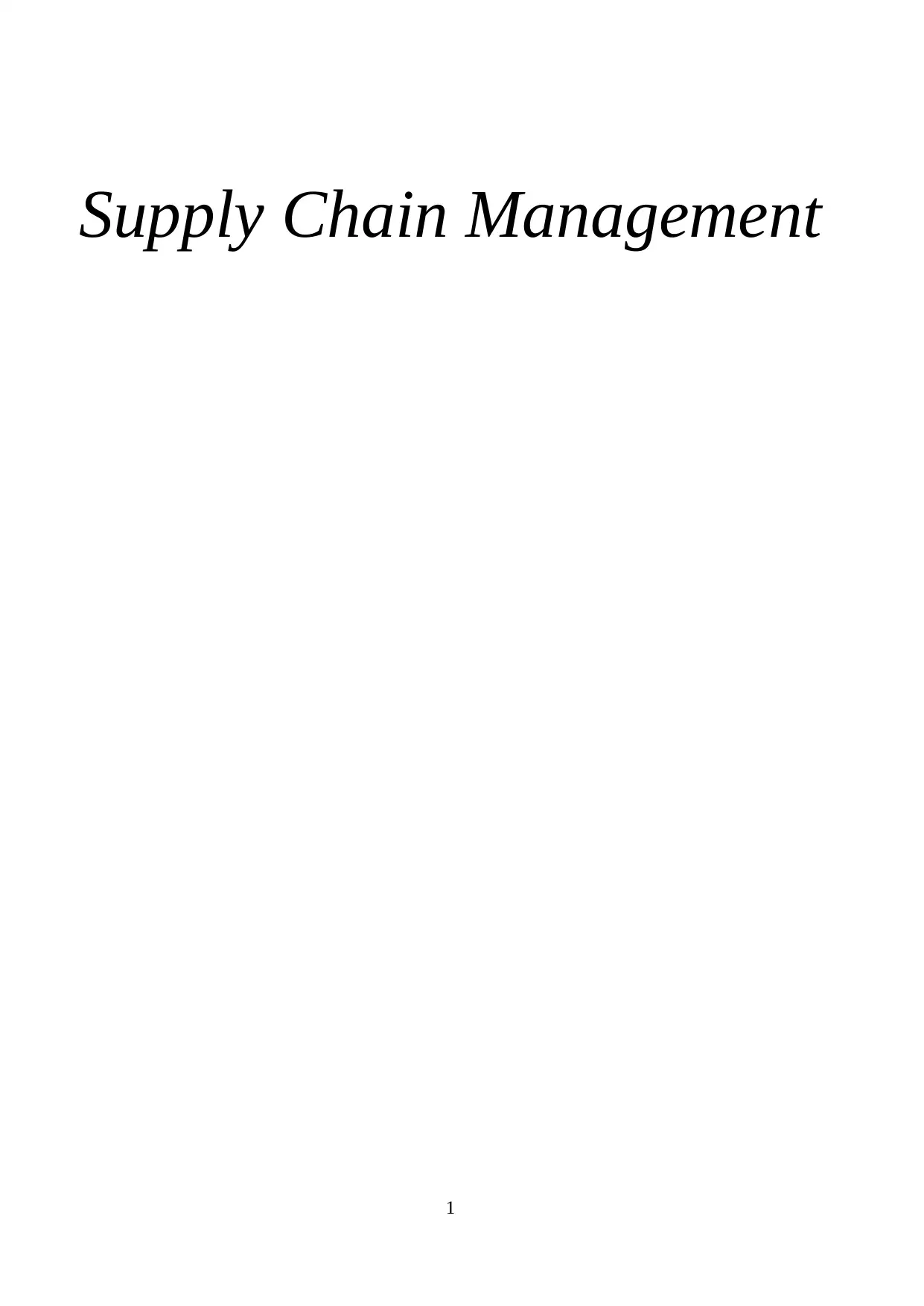
Supply Chain Management
1
1
Paraphrase This Document
Need a fresh take? Get an instant paraphrase of this document with our AI Paraphraser

TABLE OF CONTENTS
OVERVIEW OF THE COMPANY......................................................................................................3
INTRODUCTION................................................................................................................................4
LITERATURE REVIEW.....................................................................................................................4
ANALYSIS...........................................................................................................................................7
CONCLUSION....................................................................................................................................9
REFERENCES...................................................................................................................................10
2
OVERVIEW OF THE COMPANY......................................................................................................3
INTRODUCTION................................................................................................................................4
LITERATURE REVIEW.....................................................................................................................4
ANALYSIS...........................................................................................................................................7
CONCLUSION....................................................................................................................................9
REFERENCES...................................................................................................................................10
2
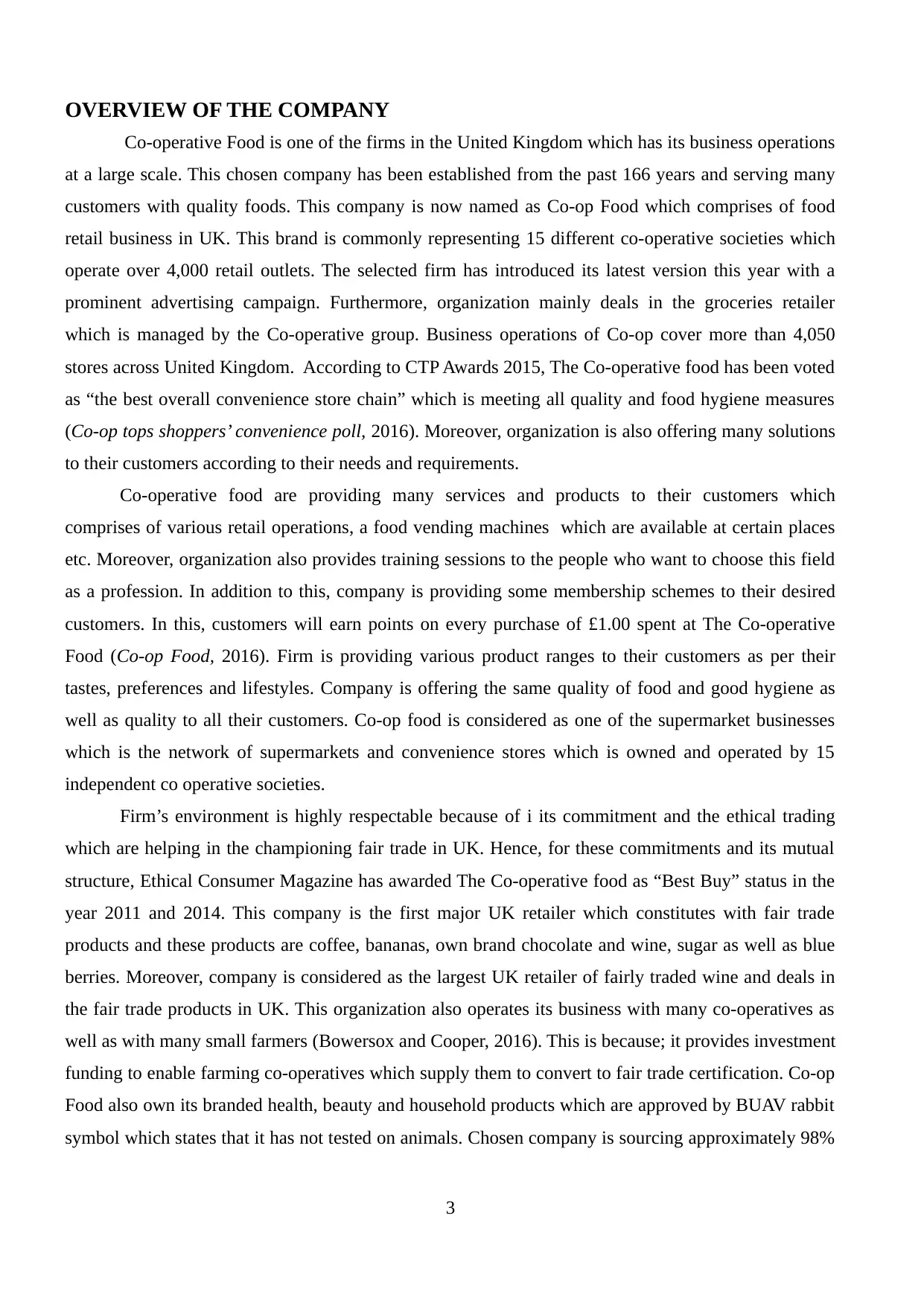
OVERVIEW OF THE COMPANY
Co-operative Food is one of the firms in the United Kingdom which has its business operations
at a large scale. This chosen company has been established from the past 166 years and serving many
customers with quality foods. This company is now named as Co-op Food which comprises of food
retail business in UK. This brand is commonly representing 15 different co-operative societies which
operate over 4,000 retail outlets. The selected firm has introduced its latest version this year with a
prominent advertising campaign. Furthermore, organization mainly deals in the groceries retailer
which is managed by the Co-operative group. Business operations of Co-op cover more than 4,050
stores across United Kingdom. According to CTP Awards 2015, The Co-operative food has been voted
as “the best overall convenience store chain” which is meeting all quality and food hygiene measures
(Co-op tops shoppers’ convenience poll, 2016). Moreover, organization is also offering many solutions
to their customers according to their needs and requirements.
Co-operative food are providing many services and products to their customers which
comprises of various retail operations, a food vending machines which are available at certain places
etc. Moreover, organization also provides training sessions to the people who want to choose this field
as a profession. In addition to this, company is providing some membership schemes to their desired
customers. In this, customers will earn points on every purchase of £1.00 spent at The Co-operative
Food (Co-op Food, 2016). Firm is providing various product ranges to their customers as per their
tastes, preferences and lifestyles. Company is offering the same quality of food and good hygiene as
well as quality to all their customers. Co-op food is considered as one of the supermarket businesses
which is the network of supermarkets and convenience stores which is owned and operated by 15
independent co operative societies.
Firm’s environment is highly respectable because of i its commitment and the ethical trading
which are helping in the championing fair trade in UK. Hence, for these commitments and its mutual
structure, Ethical Consumer Magazine has awarded The Co-operative food as “Best Buy” status in the
year 2011 and 2014. This company is the first major UK retailer which constitutes with fair trade
products and these products are coffee, bananas, own brand chocolate and wine, sugar as well as blue
berries. Moreover, company is considered as the largest UK retailer of fairly traded wine and deals in
the fair trade products in UK. This organization also operates its business with many co-operatives as
well as with many small farmers (Bowersox and Cooper, 2016). This is because; it provides investment
funding to enable farming co-operatives which supply them to convert to fair trade certification. Co-op
Food also own its branded health, beauty and household products which are approved by BUAV rabbit
symbol which states that it has not tested on animals. Chosen company is sourcing approximately 98%
3
Co-operative Food is one of the firms in the United Kingdom which has its business operations
at a large scale. This chosen company has been established from the past 166 years and serving many
customers with quality foods. This company is now named as Co-op Food which comprises of food
retail business in UK. This brand is commonly representing 15 different co-operative societies which
operate over 4,000 retail outlets. The selected firm has introduced its latest version this year with a
prominent advertising campaign. Furthermore, organization mainly deals in the groceries retailer
which is managed by the Co-operative group. Business operations of Co-op cover more than 4,050
stores across United Kingdom. According to CTP Awards 2015, The Co-operative food has been voted
as “the best overall convenience store chain” which is meeting all quality and food hygiene measures
(Co-op tops shoppers’ convenience poll, 2016). Moreover, organization is also offering many solutions
to their customers according to their needs and requirements.
Co-operative food are providing many services and products to their customers which
comprises of various retail operations, a food vending machines which are available at certain places
etc. Moreover, organization also provides training sessions to the people who want to choose this field
as a profession. In addition to this, company is providing some membership schemes to their desired
customers. In this, customers will earn points on every purchase of £1.00 spent at The Co-operative
Food (Co-op Food, 2016). Firm is providing various product ranges to their customers as per their
tastes, preferences and lifestyles. Company is offering the same quality of food and good hygiene as
well as quality to all their customers. Co-op food is considered as one of the supermarket businesses
which is the network of supermarkets and convenience stores which is owned and operated by 15
independent co operative societies.
Firm’s environment is highly respectable because of i its commitment and the ethical trading
which are helping in the championing fair trade in UK. Hence, for these commitments and its mutual
structure, Ethical Consumer Magazine has awarded The Co-operative food as “Best Buy” status in the
year 2011 and 2014. This company is the first major UK retailer which constitutes with fair trade
products and these products are coffee, bananas, own brand chocolate and wine, sugar as well as blue
berries. Moreover, company is considered as the largest UK retailer of fairly traded wine and deals in
the fair trade products in UK. This organization also operates its business with many co-operatives as
well as with many small farmers (Bowersox and Cooper, 2016). This is because; it provides investment
funding to enable farming co-operatives which supply them to convert to fair trade certification. Co-op
Food also own its branded health, beauty and household products which are approved by BUAV rabbit
symbol which states that it has not tested on animals. Chosen company is sourcing approximately 98%
3
⊘ This is a preview!⊘
Do you want full access?
Subscribe today to unlock all pages.

Trusted by 1+ million students worldwide
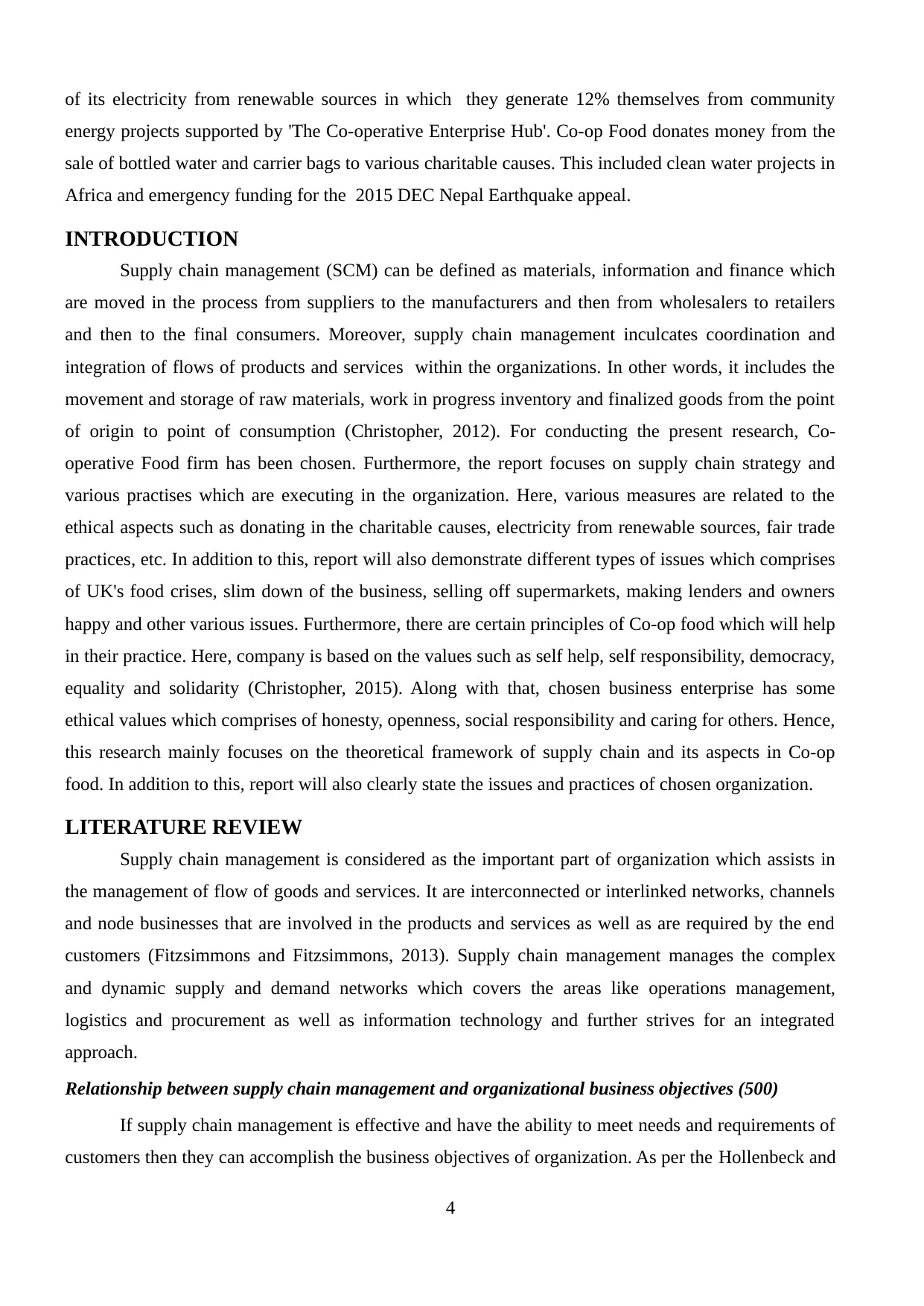
of its electricity from renewable sources in which they generate 12% themselves from community
energy projects supported by 'The Co-operative Enterprise Hub'. Co-op Food donates money from the
sale of bottled water and carrier bags to various charitable causes. This included clean water projects in
Africa and emergency funding for the 2015 DEC Nepal Earthquake appeal.
INTRODUCTION
Supply chain management (SCM) can be defined as materials, information and finance which
are moved in the process from suppliers to the manufacturers and then from wholesalers to retailers
and then to the final consumers. Moreover, supply chain management inculcates coordination and
integration of flows of products and services within the organizations. In other words, it includes the
movement and storage of raw materials, work in progress inventory and finalized goods from the point
of origin to point of consumption (Christopher, 2012). For conducting the present research, Co-
operative Food firm has been chosen. Furthermore, the report focuses on supply chain strategy and
various practises which are executing in the organization. Here, various measures are related to the
ethical aspects such as donating in the charitable causes, electricity from renewable sources, fair trade
practices, etc. In addition to this, report will also demonstrate different types of issues which comprises
of UK's food crises, slim down of the business, selling off supermarkets, making lenders and owners
happy and other various issues. Furthermore, there are certain principles of Co-op food which will help
in their practice. Here, company is based on the values such as self help, self responsibility, democracy,
equality and solidarity (Christopher, 2015). Along with that, chosen business enterprise has some
ethical values which comprises of honesty, openness, social responsibility and caring for others. Hence,
this research mainly focuses on the theoretical framework of supply chain and its aspects in Co-op
food. In addition to this, report will also clearly state the issues and practices of chosen organization.
LITERATURE REVIEW
Supply chain management is considered as the important part of organization which assists in
the management of flow of goods and services. It are interconnected or interlinked networks, channels
and node businesses that are involved in the products and services as well as are required by the end
customers (Fitzsimmons and Fitzsimmons, 2013). Supply chain management manages the complex
and dynamic supply and demand networks which covers the areas like operations management,
logistics and procurement as well as information technology and further strives for an integrated
approach.
Relationship between supply chain management and organizational business objectives (500)
If supply chain management is effective and have the ability to meet needs and requirements of
customers then they can accomplish the business objectives of organization. As per the Hollenbeck and
4
energy projects supported by 'The Co-operative Enterprise Hub'. Co-op Food donates money from the
sale of bottled water and carrier bags to various charitable causes. This included clean water projects in
Africa and emergency funding for the 2015 DEC Nepal Earthquake appeal.
INTRODUCTION
Supply chain management (SCM) can be defined as materials, information and finance which
are moved in the process from suppliers to the manufacturers and then from wholesalers to retailers
and then to the final consumers. Moreover, supply chain management inculcates coordination and
integration of flows of products and services within the organizations. In other words, it includes the
movement and storage of raw materials, work in progress inventory and finalized goods from the point
of origin to point of consumption (Christopher, 2012). For conducting the present research, Co-
operative Food firm has been chosen. Furthermore, the report focuses on supply chain strategy and
various practises which are executing in the organization. Here, various measures are related to the
ethical aspects such as donating in the charitable causes, electricity from renewable sources, fair trade
practices, etc. In addition to this, report will also demonstrate different types of issues which comprises
of UK's food crises, slim down of the business, selling off supermarkets, making lenders and owners
happy and other various issues. Furthermore, there are certain principles of Co-op food which will help
in their practice. Here, company is based on the values such as self help, self responsibility, democracy,
equality and solidarity (Christopher, 2015). Along with that, chosen business enterprise has some
ethical values which comprises of honesty, openness, social responsibility and caring for others. Hence,
this research mainly focuses on the theoretical framework of supply chain and its aspects in Co-op
food. In addition to this, report will also clearly state the issues and practices of chosen organization.
LITERATURE REVIEW
Supply chain management is considered as the important part of organization which assists in
the management of flow of goods and services. It are interconnected or interlinked networks, channels
and node businesses that are involved in the products and services as well as are required by the end
customers (Fitzsimmons and Fitzsimmons, 2013). Supply chain management manages the complex
and dynamic supply and demand networks which covers the areas like operations management,
logistics and procurement as well as information technology and further strives for an integrated
approach.
Relationship between supply chain management and organizational business objectives (500)
If supply chain management is effective and have the ability to meet needs and requirements of
customers then they can accomplish the business objectives of organization. As per the Hollenbeck and
4
Paraphrase This Document
Need a fresh take? Get an instant paraphrase of this document with our AI Paraphraser
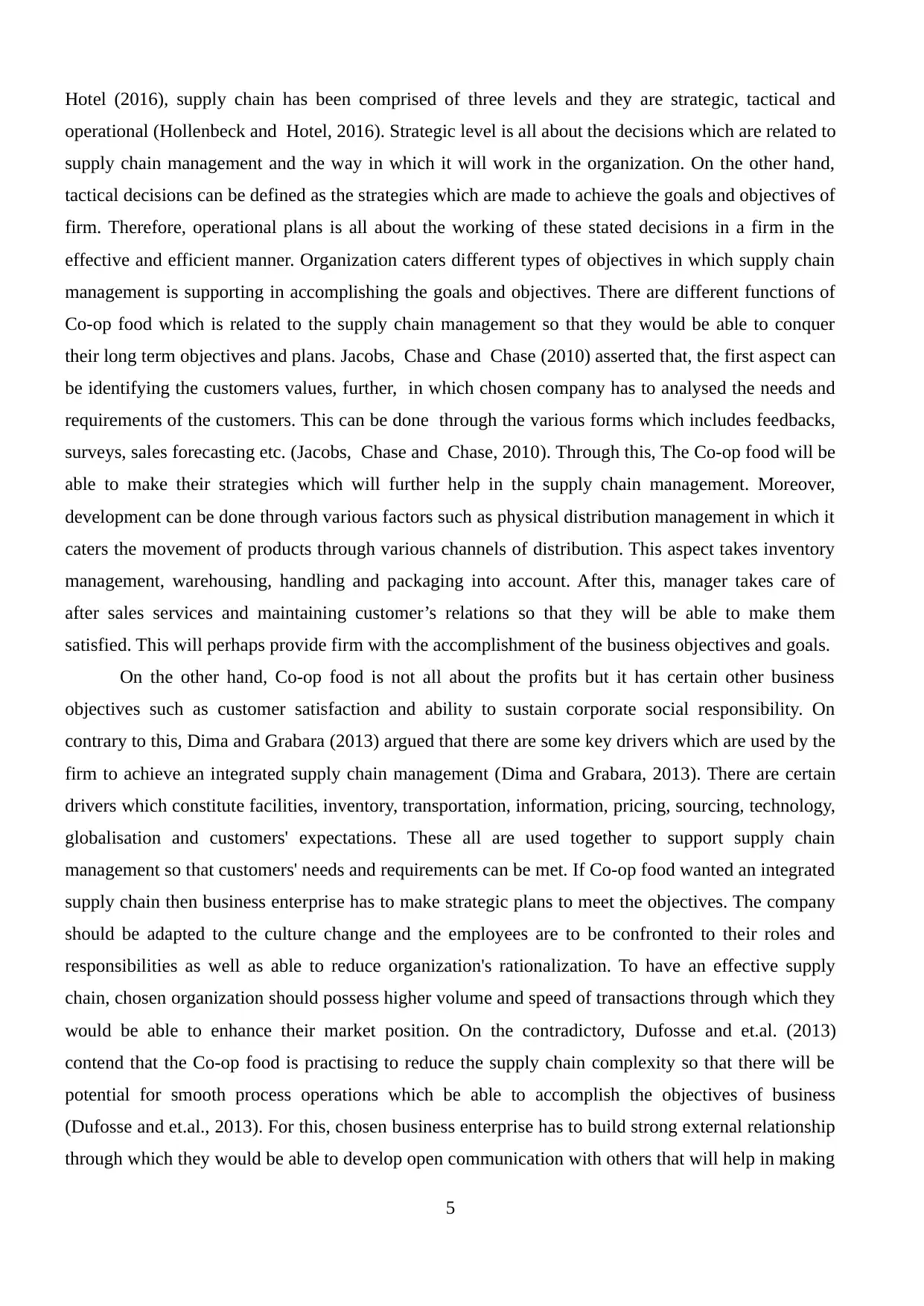
Hotel (2016), supply chain has been comprised of three levels and they are strategic, tactical and
operational (Hollenbeck and Hotel, 2016). Strategic level is all about the decisions which are related to
supply chain management and the way in which it will work in the organization. On the other hand,
tactical decisions can be defined as the strategies which are made to achieve the goals and objectives of
firm. Therefore, operational plans is all about the working of these stated decisions in a firm in the
effective and efficient manner. Organization caters different types of objectives in which supply chain
management is supporting in accomplishing the goals and objectives. There are different functions of
Co-op food which is related to the supply chain management so that they would be able to conquer
their long term objectives and plans. Jacobs, Chase and Chase (2010) asserted that, the first aspect can
be identifying the customers values, further, in which chosen company has to analysed the needs and
requirements of the customers. This can be done through the various forms which includes feedbacks,
surveys, sales forecasting etc. (Jacobs, Chase and Chase, 2010). Through this, The Co-op food will be
able to make their strategies which will further help in the supply chain management. Moreover,
development can be done through various factors such as physical distribution management in which it
caters the movement of products through various channels of distribution. This aspect takes inventory
management, warehousing, handling and packaging into account. After this, manager takes care of
after sales services and maintaining customer’s relations so that they will be able to make them
satisfied. This will perhaps provide firm with the accomplishment of the business objectives and goals.
On the other hand, Co-op food is not all about the profits but it has certain other business
objectives such as customer satisfaction and ability to sustain corporate social responsibility. On
contrary to this, Dima and Grabara (2013) argued that there are some key drivers which are used by the
firm to achieve an integrated supply chain management (Dima and Grabara, 2013). There are certain
drivers which constitute facilities, inventory, transportation, information, pricing, sourcing, technology,
globalisation and customers' expectations. These all are used together to support supply chain
management so that customers' needs and requirements can be met. If Co-op food wanted an integrated
supply chain then business enterprise has to make strategic plans to meet the objectives. The company
should be adapted to the culture change and the employees are to be confronted to their roles and
responsibilities as well as able to reduce organization's rationalization. To have an effective supply
chain, chosen organization should possess higher volume and speed of transactions through which they
would be able to enhance their market position. On the contradictory, Dufosse and et.al. (2013)
contend that the Co-op food is practising to reduce the supply chain complexity so that there will be
potential for smooth process operations which be able to accomplish the objectives of business
(Dufosse and et.al., 2013). For this, chosen business enterprise has to build strong external relationship
through which they would be able to develop open communication with others that will help in making
5
operational (Hollenbeck and Hotel, 2016). Strategic level is all about the decisions which are related to
supply chain management and the way in which it will work in the organization. On the other hand,
tactical decisions can be defined as the strategies which are made to achieve the goals and objectives of
firm. Therefore, operational plans is all about the working of these stated decisions in a firm in the
effective and efficient manner. Organization caters different types of objectives in which supply chain
management is supporting in accomplishing the goals and objectives. There are different functions of
Co-op food which is related to the supply chain management so that they would be able to conquer
their long term objectives and plans. Jacobs, Chase and Chase (2010) asserted that, the first aspect can
be identifying the customers values, further, in which chosen company has to analysed the needs and
requirements of the customers. This can be done through the various forms which includes feedbacks,
surveys, sales forecasting etc. (Jacobs, Chase and Chase, 2010). Through this, The Co-op food will be
able to make their strategies which will further help in the supply chain management. Moreover,
development can be done through various factors such as physical distribution management in which it
caters the movement of products through various channels of distribution. This aspect takes inventory
management, warehousing, handling and packaging into account. After this, manager takes care of
after sales services and maintaining customer’s relations so that they will be able to make them
satisfied. This will perhaps provide firm with the accomplishment of the business objectives and goals.
On the other hand, Co-op food is not all about the profits but it has certain other business
objectives such as customer satisfaction and ability to sustain corporate social responsibility. On
contrary to this, Dima and Grabara (2013) argued that there are some key drivers which are used by the
firm to achieve an integrated supply chain management (Dima and Grabara, 2013). There are certain
drivers which constitute facilities, inventory, transportation, information, pricing, sourcing, technology,
globalisation and customers' expectations. These all are used together to support supply chain
management so that customers' needs and requirements can be met. If Co-op food wanted an integrated
supply chain then business enterprise has to make strategic plans to meet the objectives. The company
should be adapted to the culture change and the employees are to be confronted to their roles and
responsibilities as well as able to reduce organization's rationalization. To have an effective supply
chain, chosen organization should possess higher volume and speed of transactions through which they
would be able to enhance their market position. On the contradictory, Dufosse and et.al. (2013)
contend that the Co-op food is practising to reduce the supply chain complexity so that there will be
potential for smooth process operations which be able to accomplish the objectives of business
(Dufosse and et.al., 2013). For this, chosen business enterprise has to build strong external relationship
through which they would be able to develop open communication with others that will help in making
5
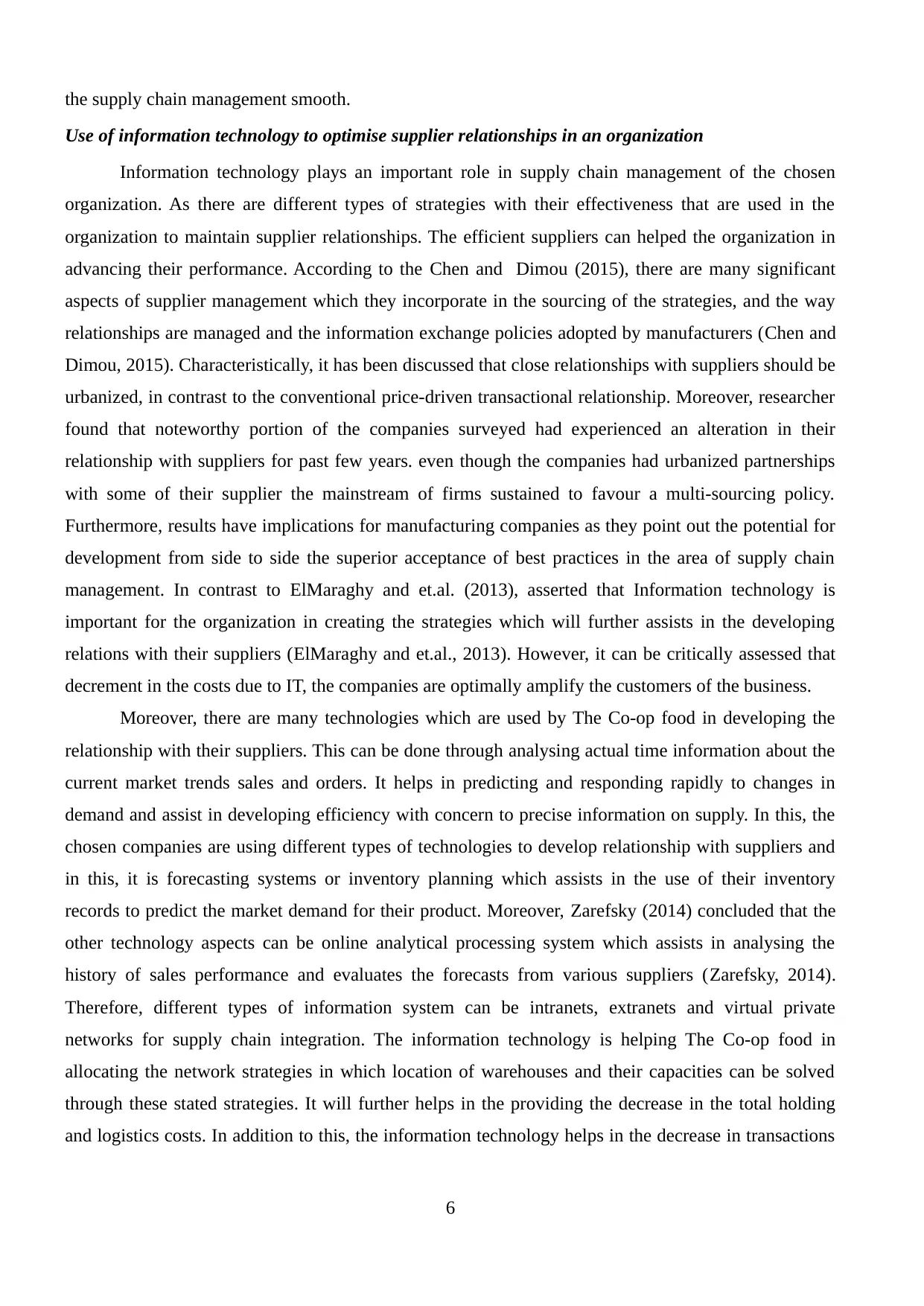
the supply chain management smooth.
Use of information technology to optimise supplier relationships in an organization
Information technology plays an important role in supply chain management of the chosen
organization. As there are different types of strategies with their effectiveness that are used in the
organization to maintain supplier relationships. The efficient suppliers can helped the organization in
advancing their performance. According to the Chen and Dimou (2015), there are many significant
aspects of supplier management which they incorporate in the sourcing of the strategies, and the way
relationships are managed and the information exchange policies adopted by manufacturers (Chen and
Dimou, 2015). Characteristically, it has been discussed that close relationships with suppliers should be
urbanized, in contrast to the conventional price-driven transactional relationship. Moreover, researcher
found that noteworthy portion of the companies surveyed had experienced an alteration in their
relationship with suppliers for past few years. even though the companies had urbanized partnerships
with some of their supplier the mainstream of firms sustained to favour a multi-sourcing policy.
Furthermore, results have implications for manufacturing companies as they point out the potential for
development from side to side the superior acceptance of best practices in the area of supply chain
management. In contrast to ElMaraghy and et.al. (2013), asserted that Information technology is
important for the organization in creating the strategies which will further assists in the developing
relations with their suppliers (ElMaraghy and et.al., 2013). However, it can be critically assessed that
decrement in the costs due to IT, the companies are optimally amplify the customers of the business.
Moreover, there are many technologies which are used by The Co-op food in developing the
relationship with their suppliers. This can be done through analysing actual time information about the
current market trends sales and orders. It helps in predicting and responding rapidly to changes in
demand and assist in developing efficiency with concern to precise information on supply. In this, the
chosen companies are using different types of technologies to develop relationship with suppliers and
in this, it is forecasting systems or inventory planning which assists in the use of their inventory
records to predict the market demand for their product. Moreover, Zarefsky (2014) concluded that the
other technology aspects can be online analytical processing system which assists in analysing the
history of sales performance and evaluates the forecasts from various suppliers (Zarefsky, 2014).
Therefore, different types of information system can be intranets, extranets and virtual private
networks for supply chain integration. The information technology is helping The Co-op food in
allocating the network strategies in which location of warehouses and their capacities can be solved
through these stated strategies. It will further helps in the providing the decrease in the total holding
and logistics costs. In addition to this, the information technology helps in the decrease in transactions
6
Use of information technology to optimise supplier relationships in an organization
Information technology plays an important role in supply chain management of the chosen
organization. As there are different types of strategies with their effectiveness that are used in the
organization to maintain supplier relationships. The efficient suppliers can helped the organization in
advancing their performance. According to the Chen and Dimou (2015), there are many significant
aspects of supplier management which they incorporate in the sourcing of the strategies, and the way
relationships are managed and the information exchange policies adopted by manufacturers (Chen and
Dimou, 2015). Characteristically, it has been discussed that close relationships with suppliers should be
urbanized, in contrast to the conventional price-driven transactional relationship. Moreover, researcher
found that noteworthy portion of the companies surveyed had experienced an alteration in their
relationship with suppliers for past few years. even though the companies had urbanized partnerships
with some of their supplier the mainstream of firms sustained to favour a multi-sourcing policy.
Furthermore, results have implications for manufacturing companies as they point out the potential for
development from side to side the superior acceptance of best practices in the area of supply chain
management. In contrast to ElMaraghy and et.al. (2013), asserted that Information technology is
important for the organization in creating the strategies which will further assists in the developing
relations with their suppliers (ElMaraghy and et.al., 2013). However, it can be critically assessed that
decrement in the costs due to IT, the companies are optimally amplify the customers of the business.
Moreover, there are many technologies which are used by The Co-op food in developing the
relationship with their suppliers. This can be done through analysing actual time information about the
current market trends sales and orders. It helps in predicting and responding rapidly to changes in
demand and assist in developing efficiency with concern to precise information on supply. In this, the
chosen companies are using different types of technologies to develop relationship with suppliers and
in this, it is forecasting systems or inventory planning which assists in the use of their inventory
records to predict the market demand for their product. Moreover, Zarefsky (2014) concluded that the
other technology aspects can be online analytical processing system which assists in analysing the
history of sales performance and evaluates the forecasts from various suppliers (Zarefsky, 2014).
Therefore, different types of information system can be intranets, extranets and virtual private
networks for supply chain integration. The information technology is helping The Co-op food in
allocating the network strategies in which location of warehouses and their capacities can be solved
through these stated strategies. It will further helps in the providing the decrease in the total holding
and logistics costs. In addition to this, the information technology helps in the decrease in transactions
6
⊘ This is a preview!⊘
Do you want full access?
Subscribe today to unlock all pages.

Trusted by 1+ million students worldwide
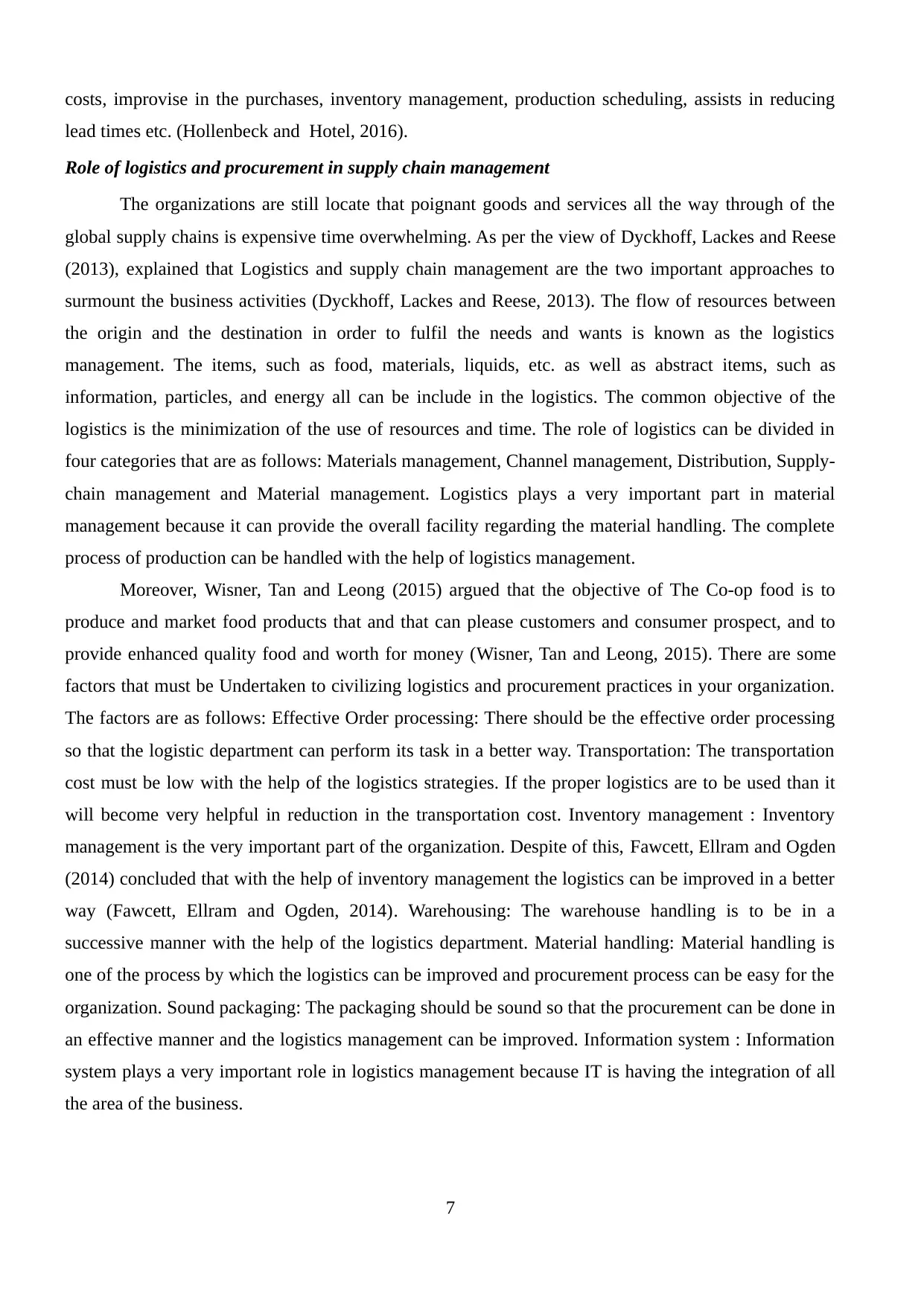
costs, improvise in the purchases, inventory management, production scheduling, assists in reducing
lead times etc. (Hollenbeck and Hotel, 2016).
Role of logistics and procurement in supply chain management
The organizations are still locate that poignant goods and services all the way through of the
global supply chains is expensive time overwhelming. As per the view of Dyckhoff, Lackes and Reese
(2013), explained that Logistics and supply chain management are the two important approaches to
surmount the business activities (Dyckhoff, Lackes and Reese, 2013). The flow of resources between
the origin and the destination in order to fulfil the needs and wants is known as the logistics
management. The items, such as food, materials, liquids, etc. as well as abstract items, such as
information, particles, and energy all can be include in the logistics. The common objective of the
logistics is the minimization of the use of resources and time. The role of logistics can be divided in
four categories that are as follows: Materials management, Channel management, Distribution, Supply-
chain management and Material management. Logistics plays a very important part in material
management because it can provide the overall facility regarding the material handling. The complete
process of production can be handled with the help of logistics management.
Moreover, Wisner, Tan and Leong (2015) argued that the objective of The Co-op food is to
produce and market food products that and that can please customers and consumer prospect, and to
provide enhanced quality food and worth for money (Wisner, Tan and Leong, 2015). There are some
factors that must be Undertaken to civilizing logistics and procurement practices in your organization.
The factors are as follows: Effective Order processing: There should be the effective order processing
so that the logistic department can perform its task in a better way. Transportation: The transportation
cost must be low with the help of the logistics strategies. If the proper logistics are to be used than it
will become very helpful in reduction in the transportation cost. Inventory management : Inventory
management is the very important part of the organization. Despite of this, Fawcett, Ellram and Ogden
(2014) concluded that with the help of inventory management the logistics can be improved in a better
way (Fawcett, Ellram and Ogden, 2014). Warehousing: The warehouse handling is to be in a
successive manner with the help of the logistics department. Material handling: Material handling is
one of the process by which the logistics can be improved and procurement process can be easy for the
organization. Sound packaging: The packaging should be sound so that the procurement can be done in
an effective manner and the logistics management can be improved. Information system : Information
system plays a very important role in logistics management because IT is having the integration of all
the area of the business.
7
lead times etc. (Hollenbeck and Hotel, 2016).
Role of logistics and procurement in supply chain management
The organizations are still locate that poignant goods and services all the way through of the
global supply chains is expensive time overwhelming. As per the view of Dyckhoff, Lackes and Reese
(2013), explained that Logistics and supply chain management are the two important approaches to
surmount the business activities (Dyckhoff, Lackes and Reese, 2013). The flow of resources between
the origin and the destination in order to fulfil the needs and wants is known as the logistics
management. The items, such as food, materials, liquids, etc. as well as abstract items, such as
information, particles, and energy all can be include in the logistics. The common objective of the
logistics is the minimization of the use of resources and time. The role of logistics can be divided in
four categories that are as follows: Materials management, Channel management, Distribution, Supply-
chain management and Material management. Logistics plays a very important part in material
management because it can provide the overall facility regarding the material handling. The complete
process of production can be handled with the help of logistics management.
Moreover, Wisner, Tan and Leong (2015) argued that the objective of The Co-op food is to
produce and market food products that and that can please customers and consumer prospect, and to
provide enhanced quality food and worth for money (Wisner, Tan and Leong, 2015). There are some
factors that must be Undertaken to civilizing logistics and procurement practices in your organization.
The factors are as follows: Effective Order processing: There should be the effective order processing
so that the logistic department can perform its task in a better way. Transportation: The transportation
cost must be low with the help of the logistics strategies. If the proper logistics are to be used than it
will become very helpful in reduction in the transportation cost. Inventory management : Inventory
management is the very important part of the organization. Despite of this, Fawcett, Ellram and Ogden
(2014) concluded that with the help of inventory management the logistics can be improved in a better
way (Fawcett, Ellram and Ogden, 2014). Warehousing: The warehouse handling is to be in a
successive manner with the help of the logistics department. Material handling: Material handling is
one of the process by which the logistics can be improved and procurement process can be easy for the
organization. Sound packaging: The packaging should be sound so that the procurement can be done in
an effective manner and the logistics management can be improved. Information system : Information
system plays a very important role in logistics management because IT is having the integration of all
the area of the business.
7
Paraphrase This Document
Need a fresh take? Get an instant paraphrase of this document with our AI Paraphraser
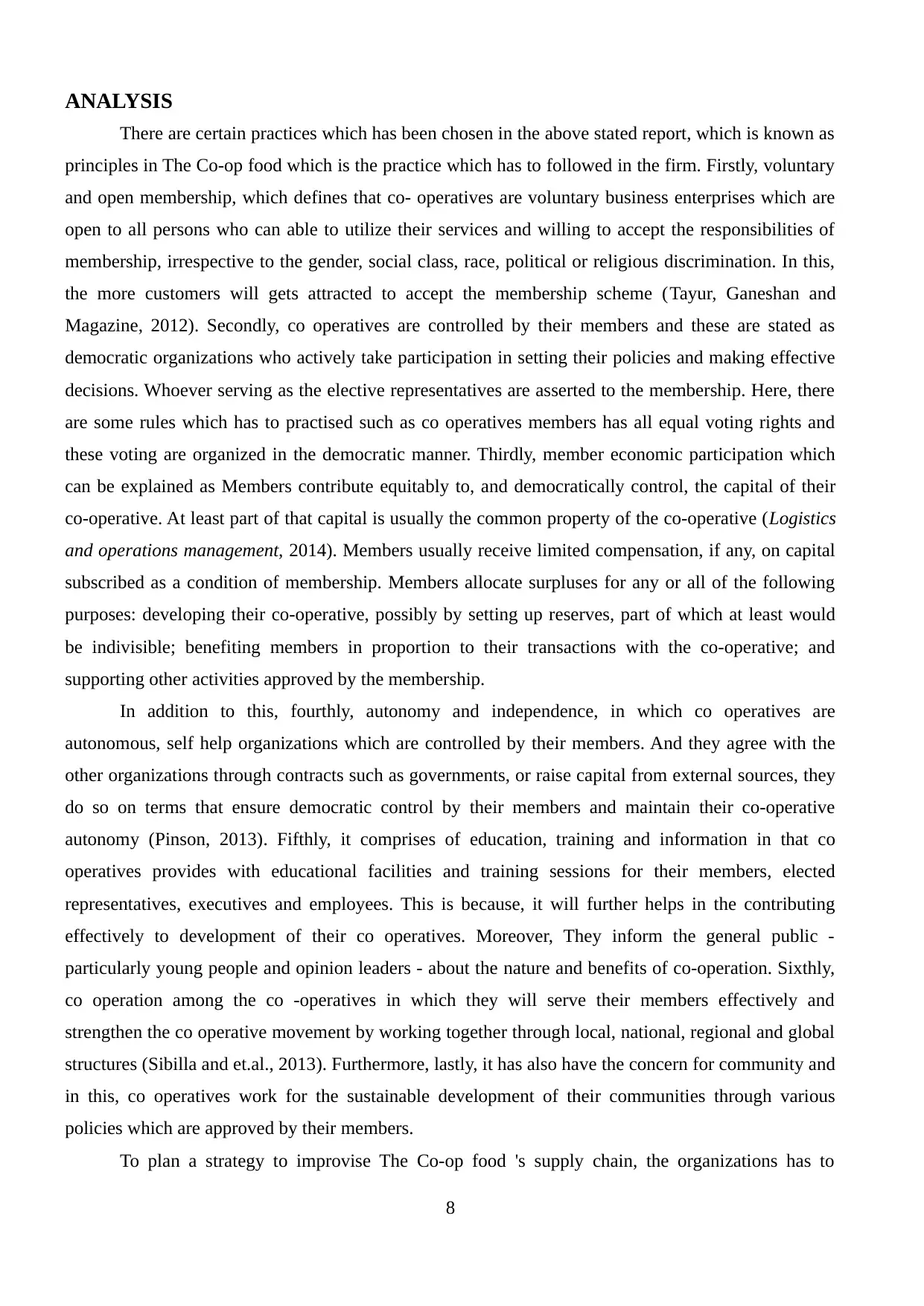
ANALYSIS
There are certain practices which has been chosen in the above stated report, which is known as
principles in The Co-op food which is the practice which has to followed in the firm. Firstly, voluntary
and open membership, which defines that co- operatives are voluntary business enterprises which are
open to all persons who can able to utilize their services and willing to accept the responsibilities of
membership, irrespective to the gender, social class, race, political or religious discrimination. In this,
the more customers will gets attracted to accept the membership scheme (Tayur, Ganeshan and
Magazine, 2012). Secondly, co operatives are controlled by their members and these are stated as
democratic organizations who actively take participation in setting their policies and making effective
decisions. Whoever serving as the elective representatives are asserted to the membership. Here, there
are some rules which has to practised such as co operatives members has all equal voting rights and
these voting are organized in the democratic manner. Thirdly, member economic participation which
can be explained as Members contribute equitably to, and democratically control, the capital of their
co-operative. At least part of that capital is usually the common property of the co-operative (Logistics
and operations management, 2014). Members usually receive limited compensation, if any, on capital
subscribed as a condition of membership. Members allocate surpluses for any or all of the following
purposes: developing their co-operative, possibly by setting up reserves, part of which at least would
be indivisible; benefiting members in proportion to their transactions with the co-operative; and
supporting other activities approved by the membership.
In addition to this, fourthly, autonomy and independence, in which co operatives are
autonomous, self help organizations which are controlled by their members. And they agree with the
other organizations through contracts such as governments, or raise capital from external sources, they
do so on terms that ensure democratic control by their members and maintain their co-operative
autonomy (Pinson, 2013). Fifthly, it comprises of education, training and information in that co
operatives provides with educational facilities and training sessions for their members, elected
representatives, executives and employees. This is because, it will further helps in the contributing
effectively to development of their co operatives. Moreover, They inform the general public -
particularly young people and opinion leaders - about the nature and benefits of co-operation. Sixthly,
co operation among the co -operatives in which they will serve their members effectively and
strengthen the co operative movement by working together through local, national, regional and global
structures (Sibilla and et.al., 2013). Furthermore, lastly, it has also have the concern for community and
in this, co operatives work for the sustainable development of their communities through various
policies which are approved by their members.
To plan a strategy to improvise The Co-op food 's supply chain, the organizations has to
8
There are certain practices which has been chosen in the above stated report, which is known as
principles in The Co-op food which is the practice which has to followed in the firm. Firstly, voluntary
and open membership, which defines that co- operatives are voluntary business enterprises which are
open to all persons who can able to utilize their services and willing to accept the responsibilities of
membership, irrespective to the gender, social class, race, political or religious discrimination. In this,
the more customers will gets attracted to accept the membership scheme (Tayur, Ganeshan and
Magazine, 2012). Secondly, co operatives are controlled by their members and these are stated as
democratic organizations who actively take participation in setting their policies and making effective
decisions. Whoever serving as the elective representatives are asserted to the membership. Here, there
are some rules which has to practised such as co operatives members has all equal voting rights and
these voting are organized in the democratic manner. Thirdly, member economic participation which
can be explained as Members contribute equitably to, and democratically control, the capital of their
co-operative. At least part of that capital is usually the common property of the co-operative (Logistics
and operations management, 2014). Members usually receive limited compensation, if any, on capital
subscribed as a condition of membership. Members allocate surpluses for any or all of the following
purposes: developing their co-operative, possibly by setting up reserves, part of which at least would
be indivisible; benefiting members in proportion to their transactions with the co-operative; and
supporting other activities approved by the membership.
In addition to this, fourthly, autonomy and independence, in which co operatives are
autonomous, self help organizations which are controlled by their members. And they agree with the
other organizations through contracts such as governments, or raise capital from external sources, they
do so on terms that ensure democratic control by their members and maintain their co-operative
autonomy (Pinson, 2013). Fifthly, it comprises of education, training and information in that co
operatives provides with educational facilities and training sessions for their members, elected
representatives, executives and employees. This is because, it will further helps in the contributing
effectively to development of their co operatives. Moreover, They inform the general public -
particularly young people and opinion leaders - about the nature and benefits of co-operation. Sixthly,
co operation among the co -operatives in which they will serve their members effectively and
strengthen the co operative movement by working together through local, national, regional and global
structures (Sibilla and et.al., 2013). Furthermore, lastly, it has also have the concern for community and
in this, co operatives work for the sustainable development of their communities through various
policies which are approved by their members.
To plan a strategy to improvise The Co-op food 's supply chain, the organizations has to
8
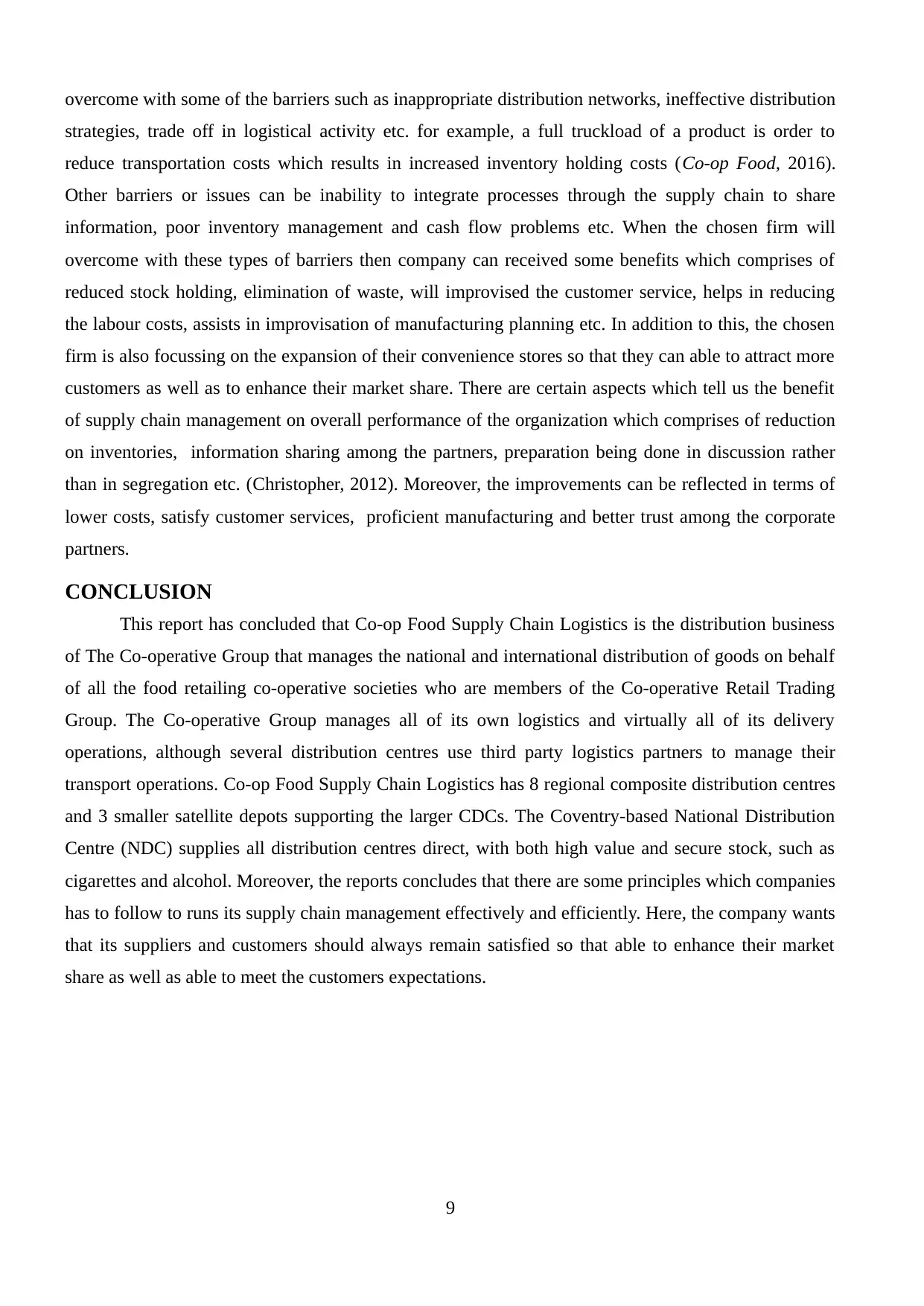
overcome with some of the barriers such as inappropriate distribution networks, ineffective distribution
strategies, trade off in logistical activity etc. for example, a full truckload of a product is order to
reduce transportation costs which results in increased inventory holding costs (Co-op Food, 2016).
Other barriers or issues can be inability to integrate processes through the supply chain to share
information, poor inventory management and cash flow problems etc. When the chosen firm will
overcome with these types of barriers then company can received some benefits which comprises of
reduced stock holding, elimination of waste, will improvised the customer service, helps in reducing
the labour costs, assists in improvisation of manufacturing planning etc. In addition to this, the chosen
firm is also focussing on the expansion of their convenience stores so that they can able to attract more
customers as well as to enhance their market share. There are certain aspects which tell us the benefit
of supply chain management on overall performance of the organization which comprises of reduction
on inventories, information sharing among the partners, preparation being done in discussion rather
than in segregation etc. (Christopher, 2012). Moreover, the improvements can be reflected in terms of
lower costs, satisfy customer services, proficient manufacturing and better trust among the corporate
partners.
CONCLUSION
This report has concluded that Co-op Food Supply Chain Logistics is the distribution business
of The Co-operative Group that manages the national and international distribution of goods on behalf
of all the food retailing co-operative societies who are members of the Co-operative Retail Trading
Group. The Co-operative Group manages all of its own logistics and virtually all of its delivery
operations, although several distribution centres use third party logistics partners to manage their
transport operations. Co-op Food Supply Chain Logistics has 8 regional composite distribution centres
and 3 smaller satellite depots supporting the larger CDCs. The Coventry-based National Distribution
Centre (NDC) supplies all distribution centres direct, with both high value and secure stock, such as
cigarettes and alcohol. Moreover, the reports concludes that there are some principles which companies
has to follow to runs its supply chain management effectively and efficiently. Here, the company wants
that its suppliers and customers should always remain satisfied so that able to enhance their market
share as well as able to meet the customers expectations.
9
strategies, trade off in logistical activity etc. for example, a full truckload of a product is order to
reduce transportation costs which results in increased inventory holding costs (Co-op Food, 2016).
Other barriers or issues can be inability to integrate processes through the supply chain to share
information, poor inventory management and cash flow problems etc. When the chosen firm will
overcome with these types of barriers then company can received some benefits which comprises of
reduced stock holding, elimination of waste, will improvised the customer service, helps in reducing
the labour costs, assists in improvisation of manufacturing planning etc. In addition to this, the chosen
firm is also focussing on the expansion of their convenience stores so that they can able to attract more
customers as well as to enhance their market share. There are certain aspects which tell us the benefit
of supply chain management on overall performance of the organization which comprises of reduction
on inventories, information sharing among the partners, preparation being done in discussion rather
than in segregation etc. (Christopher, 2012). Moreover, the improvements can be reflected in terms of
lower costs, satisfy customer services, proficient manufacturing and better trust among the corporate
partners.
CONCLUSION
This report has concluded that Co-op Food Supply Chain Logistics is the distribution business
of The Co-operative Group that manages the national and international distribution of goods on behalf
of all the food retailing co-operative societies who are members of the Co-operative Retail Trading
Group. The Co-operative Group manages all of its own logistics and virtually all of its delivery
operations, although several distribution centres use third party logistics partners to manage their
transport operations. Co-op Food Supply Chain Logistics has 8 regional composite distribution centres
and 3 smaller satellite depots supporting the larger CDCs. The Coventry-based National Distribution
Centre (NDC) supplies all distribution centres direct, with both high value and secure stock, such as
cigarettes and alcohol. Moreover, the reports concludes that there are some principles which companies
has to follow to runs its supply chain management effectively and efficiently. Here, the company wants
that its suppliers and customers should always remain satisfied so that able to enhance their market
share as well as able to meet the customers expectations.
9
⊘ This is a preview!⊘
Do you want full access?
Subscribe today to unlock all pages.

Trusted by 1+ million students worldwide
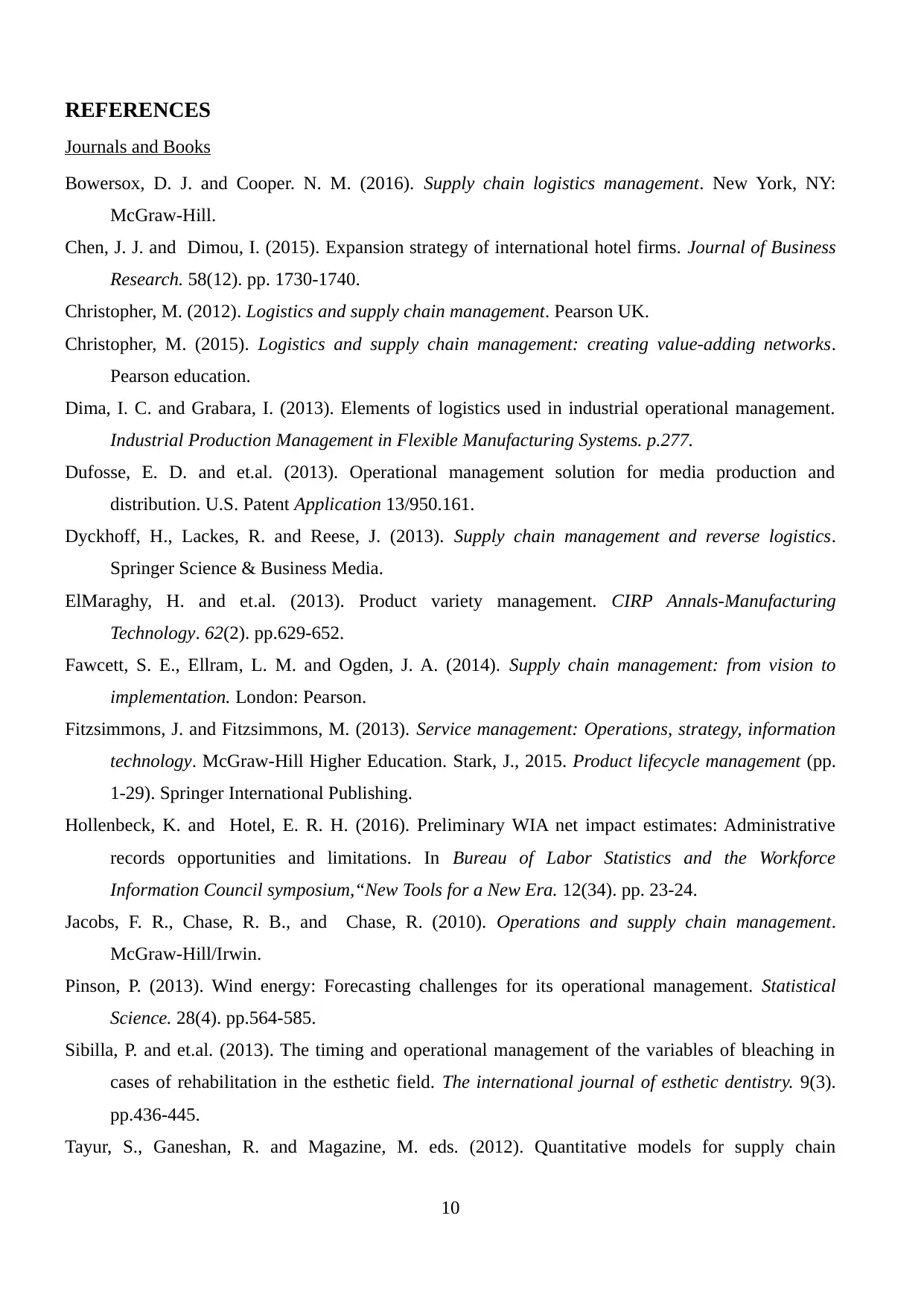
REFERENCES
Journals and Books
Bowersox, D. J. and Cooper. N. M. (2016). Supply chain logistics management. New York, NY:
McGraw-Hill.
Chen, J. J. and Dimou, I. (2015). Expansion strategy of international hotel firms. Journal of Business
Research. 58(12). pp. 1730-1740.
Christopher, M. (2012). Logistics and supply chain management. Pearson UK.
Christopher, M. (2015). Logistics and supply chain management: creating value-adding networks.
Pearson education.
Dima, I. C. and Grabara, I. (2013). Elements of logistics used in industrial operational management.
Industrial Production Management in Flexible Manufacturing Systems. p.277.
Dufosse, E. D. and et.al. (2013). Operational management solution for media production and
distribution. U.S. Patent Application 13/950.161.
Dyckhoff, H., Lackes, R. and Reese, J. (2013). Supply chain management and reverse logistics.
Springer Science & Business Media.
ElMaraghy, H. and et.al. (2013). Product variety management. CIRP Annals-Manufacturing
Technology. 62(2). pp.629-652.
Fawcett, S. E., Ellram, L. M. and Ogden, J. A. (2014). Supply chain management: from vision to
implementation. London: Pearson.
Fitzsimmons, J. and Fitzsimmons, M. (2013). Service management: Operations, strategy, information
technology. McGraw-Hill Higher Education. Stark, J., 2015. Product lifecycle management (pp.
1-29). Springer International Publishing.
Hollenbeck, K. and Hotel, E. R. H. (2016). Preliminary WIA net impact estimates: Administrative
records opportunities and limitations. In Bureau of Labor Statistics and the Workforce
Information Council symposium,“New Tools for a New Era. 12(34). pp. 23-24.
Jacobs, F. R., Chase, R. B., and Chase, R. (2010). Operations and supply chain management.
McGraw-Hill/Irwin.
Pinson, P. (2013). Wind energy: Forecasting challenges for its operational management. Statistical
Science. 28(4). pp.564-585.
Sibilla, P. and et.al. (2013). The timing and operational management of the variables of bleaching in
cases of rehabilitation in the esthetic field. The international journal of esthetic dentistry. 9(3).
pp.436-445.
Tayur, S., Ganeshan, R. and Magazine, M. eds. (2012). Quantitative models for supply chain
10
Journals and Books
Bowersox, D. J. and Cooper. N. M. (2016). Supply chain logistics management. New York, NY:
McGraw-Hill.
Chen, J. J. and Dimou, I. (2015). Expansion strategy of international hotel firms. Journal of Business
Research. 58(12). pp. 1730-1740.
Christopher, M. (2012). Logistics and supply chain management. Pearson UK.
Christopher, M. (2015). Logistics and supply chain management: creating value-adding networks.
Pearson education.
Dima, I. C. and Grabara, I. (2013). Elements of logistics used in industrial operational management.
Industrial Production Management in Flexible Manufacturing Systems. p.277.
Dufosse, E. D. and et.al. (2013). Operational management solution for media production and
distribution. U.S. Patent Application 13/950.161.
Dyckhoff, H., Lackes, R. and Reese, J. (2013). Supply chain management and reverse logistics.
Springer Science & Business Media.
ElMaraghy, H. and et.al. (2013). Product variety management. CIRP Annals-Manufacturing
Technology. 62(2). pp.629-652.
Fawcett, S. E., Ellram, L. M. and Ogden, J. A. (2014). Supply chain management: from vision to
implementation. London: Pearson.
Fitzsimmons, J. and Fitzsimmons, M. (2013). Service management: Operations, strategy, information
technology. McGraw-Hill Higher Education. Stark, J., 2015. Product lifecycle management (pp.
1-29). Springer International Publishing.
Hollenbeck, K. and Hotel, E. R. H. (2016). Preliminary WIA net impact estimates: Administrative
records opportunities and limitations. In Bureau of Labor Statistics and the Workforce
Information Council symposium,“New Tools for a New Era. 12(34). pp. 23-24.
Jacobs, F. R., Chase, R. B., and Chase, R. (2010). Operations and supply chain management.
McGraw-Hill/Irwin.
Pinson, P. (2013). Wind energy: Forecasting challenges for its operational management. Statistical
Science. 28(4). pp.564-585.
Sibilla, P. and et.al. (2013). The timing and operational management of the variables of bleaching in
cases of rehabilitation in the esthetic field. The international journal of esthetic dentistry. 9(3).
pp.436-445.
Tayur, S., Ganeshan, R. and Magazine, M. eds. (2012). Quantitative models for supply chain
10
Paraphrase This Document
Need a fresh take? Get an instant paraphrase of this document with our AI Paraphraser
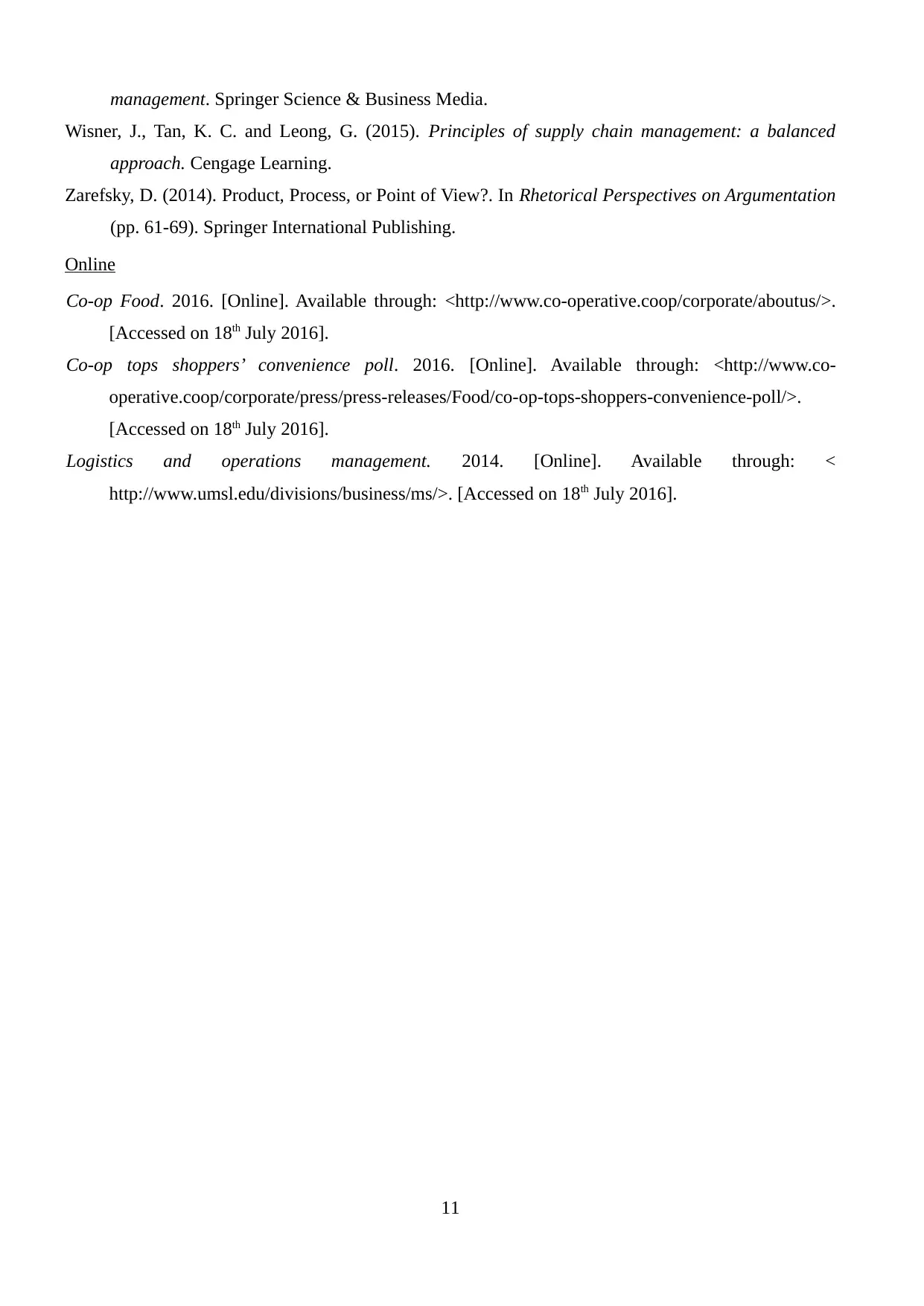
management. Springer Science & Business Media.
Wisner, J., Tan, K. C. and Leong, G. (2015). Principles of supply chain management: a balanced
approach. Cengage Learning.
Zarefsky, D. (2014). Product, Process, or Point of View?. In Rhetorical Perspectives on Argumentation
(pp. 61-69). Springer International Publishing.
Online
Co-op Food. 2016. [Online]. Available through: <http://www.co-operative.coop/corporate/aboutus/>.
[Accessed on 18th July 2016].
Co-op tops shoppers’ convenience poll. 2016. [Online]. Available through: <http://www.co-
operative.coop/corporate/press/press-releases/Food/co-op-tops-shoppers-convenience-poll/>.
[Accessed on 18th July 2016].
Logistics and operations management. 2014. [Online]. Available through: <
http://www.umsl.edu/divisions/business/ms/>. [Accessed on 18th July 2016].
11
Wisner, J., Tan, K. C. and Leong, G. (2015). Principles of supply chain management: a balanced
approach. Cengage Learning.
Zarefsky, D. (2014). Product, Process, or Point of View?. In Rhetorical Perspectives on Argumentation
(pp. 61-69). Springer International Publishing.
Online
Co-op Food. 2016. [Online]. Available through: <http://www.co-operative.coop/corporate/aboutus/>.
[Accessed on 18th July 2016].
Co-op tops shoppers’ convenience poll. 2016. [Online]. Available through: <http://www.co-
operative.coop/corporate/press/press-releases/Food/co-op-tops-shoppers-convenience-poll/>.
[Accessed on 18th July 2016].
Logistics and operations management. 2014. [Online]. Available through: <
http://www.umsl.edu/divisions/business/ms/>. [Accessed on 18th July 2016].
11

Page | 12
⊘ This is a preview!⊘
Do you want full access?
Subscribe today to unlock all pages.

Trusted by 1+ million students worldwide
1 out of 12
Related Documents
Your All-in-One AI-Powered Toolkit for Academic Success.
+13062052269
info@desklib.com
Available 24*7 on WhatsApp / Email
![[object Object]](/_next/static/media/star-bottom.7253800d.svg)
Unlock your academic potential
Copyright © 2020–2025 A2Z Services. All Rights Reserved. Developed and managed by ZUCOL.





